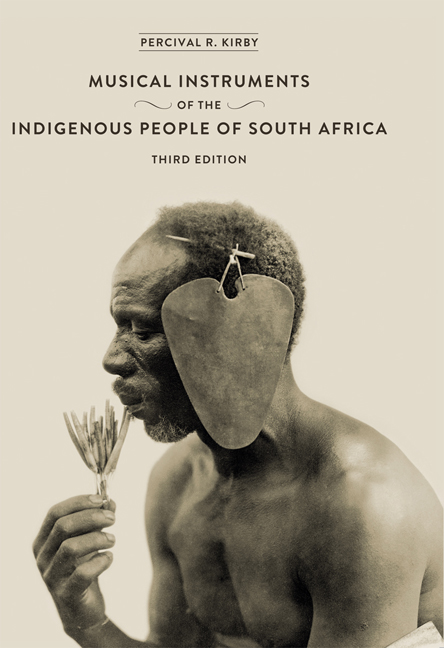Book contents
- Frontmatter
- Dedication
- Map
- Contents
- Foreword
- Preface to First Edition
- Preface to Second Edition
- Acknowledgements
- Acknowledgements to Third Edition
- List of Illustrations
- 1 Rattles and Clappers
- 2 Drums
- 3 Xylophones and ‘Sansas’
- 4 Bull-Roarers and Spinning-Disks
- 5 Horns and Trumpets
- 6 Whistles, Flutes, and Vibrating Reeds
- 7 Reed-Flute Ensembles
- 8 The ‘Gora’, A Stringed-Wind Instrument
- 9 Stringed Instruments
- 10 Bushman and Hottentot Violins and The ‘Ramkie’
- 11 Some European Instruments Played By Natives
- Appendix
- Addenda
- Index
4 - Bull-Roarers and Spinning-Disks
Published online by Cambridge University Press: 21 April 2018
- Frontmatter
- Dedication
- Map
- Contents
- Foreword
- Preface to First Edition
- Preface to Second Edition
- Acknowledgements
- Acknowledgements to Third Edition
- List of Illustrations
- 1 Rattles and Clappers
- 2 Drums
- 3 Xylophones and ‘Sansas’
- 4 Bull-Roarers and Spinning-Disks
- 5 Horns and Trumpets
- 6 Whistles, Flutes, and Vibrating Reeds
- 7 Reed-Flute Ensembles
- 8 The ‘Gora’, A Stringed-Wind Instrument
- 9 Stringed Instruments
- 10 Bushman and Hottentot Violins and The ‘Ramkie’
- 11 Some European Instruments Played By Natives
- Appendix
- Addenda
- Index
Summary
THE bull-roarer, or whizzing-stick, is found all over South Africa. There are to-day, so far as I can discover, no rituals in which the instrument is used, and no taboos regarding its employment. For the most part it is nowadays looked upon as a child's toy; and, owing to the fact that it is of no importance in the eyes of adults, information about it is very difficult to obtain.
Among the Bushmen, however, the bull-roarer was in comparatively recent times used by adults. The usual form of the instrument may be judged by the two examples shown in Figure 4.2, Nos. 2 and 3. These were made by Qung Bushmen, about 1878, for Dr. Bleek, and were given to me by Miss Dorothea Bleek. The blade of the slenderer example, a drawing of which appeared in Bleek and Lloyd's Bushman Folklore, is 127/8 inches long and 11/4 inches broad at the widest point. It is attached by a cord to a stick, by which it may be whirled through the air, when it yields a powerful sound.
Bleek and Lloyd's work contains an interesting note, in the vernacular, on the use of the instrument, which was known as the !goiŋ!goiŋ. ‘The people beat the !goiŋ!goiŋ in order that the bees may become abundant for the people, in order that the bees may go into the other people's places, that the people may eat honey. Therefore, the people beat the !goiŋ!goiŋ when they desire that the people's bees may go into the other people's places, so that the people may cut honey, that they may put honey away into bags.’ Here we see a practical use made of the bullroarer, doubtless on account of the analogy of its sound with that of swarming bees.
Two other examples of this form of the instrument as made by the Red Dunes Bushmen of the western Kalahari, are shown in Figure 4.2, Nos. 6 and 8; and two examples of a different (spinning-disk) type made by the same people in Figure 4.3, Nos. 1 and 3. These people also make a kind of bull-roarer with a feather in place of the blade of wood. An example is preserved in the Hannemann collection at Leipzig, and the instrument has been described and illustrated by Passarge. A specimen from my own collection will be seen in Figure 4.2, No. 10.
- Type
- Chapter
- Information
- Publisher: Wits University PressPrint publication year: 2013



